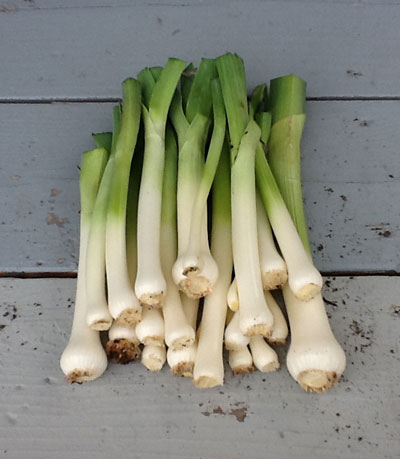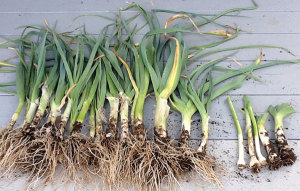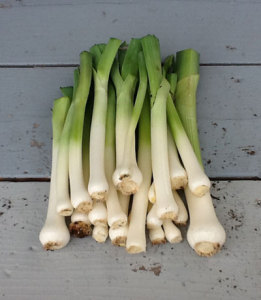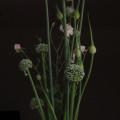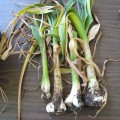Leeks are a cold-weather crop, but there’s no need to pull them when it gets warm out: letting them go to seed allows them to reseed themselves for the fall, plus the pollinators and predatory insects love their flowers. They are really cool looking, too.
Botanical Information
Taxonomy
- Allium ampeloprasum
History
- Leeks originated in the Mediterranean basin and are one of the oldest cultivated vegetables FV
- Egyptians used them as currency, along with oxen and beer FV
- They are an important ingredient in many Asian cuisines, especially kimchi FV
- Nero, the tyrannical Roman emperor, loved leeks; he believed they’d improve his singing voice; he ate them in soups and prepared in oil; he was called by some Porophagus, the leek eater FV
- Leeks are included in illustrated carvings and drawings in Egypt and Mesopotamia, dating back to the second millennium BCE SSE
- the leek is also a national emblem of the Welsh and in Henry V, Shakespeare notes the custom of wearing a leek to identify themselves is an ancient tradition for Welshman SSE
Physical Description
- hardy biennial
Varieties & Cultivars
Categories or Types of Leeks
Colors Available
Varieties to Grow
Growth Requirements
Climate & Temperature Requirements
Air Temperature
Soil Temperature
Humidity
Day Length or Light Requirements
Site Conditions Favored
Soil Requirements
Soil Texture
- prefers loamy soil SoC
pH
Nutrient Requirements
- prefers rich, loamy soil enriched with mature compost SoC
Propagation
Methods of propagation
Seed
- Timing:
- Indoors:
- mid- to late-winter SSE
- 6-8 weeks before early spring SoC
- Outdoors:
- early spring (cool soil) SoC
- Indoors:
- Depth:
- plant seeds 1/4″ deep SSE
- Temperature:
- 55-85°F
- Fertilization:
- fertilize seedlings when 2-3″ tall SSE
- Spacing:
- if starting outdoors, space them 1″ apart SSE
- Germination:
- 5-7 days SSE
- 4-12 days SoC
- 7-14 days SoC
Division
Cuttings
Transplanting or Potting Up
Seed Saving
Planting Out
- can be planted out 1-2 weeks after all danger of frost has passed SSE
Bed Prep & Soil Amendments
- make sure the soil is well-fertilized as this crop is a heavy feeder; consider adding compost to the soil the year before you plant SSE
Bed Spacing
- plant leeks 6″ apart SSE
- plant leeks 4-8″ apart SoC
Row Spacing
- 12-24″ apart SSE
Planting Depth
- plant deep enough so that 1-3″ of the plant are above the soil SSE
Alternative Bed Methods
Container Gardening
Routine Cultivation & Maintenance
Water Requirements
- keep well-watered through maturity, allowing soil surface to dry between waterings Soc
- leeks need ample water SoC
Fertilization Recommendations
- leeks may require regular applications of fertilizer SSE
Mulching & Weeding
- mulching the soil around leeks can help protect the plant and keep roots cool and moist SSE
- mulch to conserve soil moisture and control weeds SoC
Blanching
- as leeks grow, pile soil up around their base to make the white shaft longer; the soil blanches the new growth and it will just grow taller
Pinching or Pruning & Dividing
Support
Winterizing
- a deep mulch will allow harvest to continue until a hard freeze SoC
Companion Planting
Helpful Companions
Harmful Companions
Companion to..
Pests, Diseases & Problems
Common Pests
Common Diseases
Symptoms
Whole Plant
Leaves
Stem/Trunk
Flowers
Fruit
Roots
Harvesting & Storage
Edible Parts of the Plant
- the white shaft of the leek, including the light green zone, is primarily what is used in cooking
- the dark green leaves, while fibrous and inedible when fresh, turn into a fantastic spice when dried and ground to a powder (Here’s the recipe to dry leek greens or tops)
Yield
Days to Harvest / Harvest Timing
- Leeks don’t really need to be harvested, unless you live in a very cold area; otherwise, they can just wait in the ground until you need them
- when pencil thin, they tend to be sweeter than scallions and make a good winter substitute for them FV
- Aim for harvesting leeks at less than 1″ in diameter (at least for fermenting) FV
- harvest when stems are thick and succulent, but before bulbing occurs SoC
- a deep mulch will allow harvest until hard freeze SoC
Harvest Methods
- harvest whole plants by gently twisting and lifting; in heavy soils you may need to loosen soil with a fork to avoid damaging the stems SoC
Storage of harvest
Fresh
- can be stored in a root cellar
- Freshly harvested leeks can be kept for at least a week wrapped in a damp paper towel and stored in a plastic bag in the refrigerator.
Canned
Frozen
Freezing leeks seems to be the favored method of preserving them.
- Wash & slice leeks – white parts only
- Blanch for 2-3 minutes, then put them in very icy ice water
- Drain well
- Spread onto a sheet pan and freeze until hard (about 30 mins)
- Pack into freezer bags (vacuum sealers are a bonus)
To cook from frozen, boil for 8 minutes, or add directly to soups or stews. They won’t brown & crisp nicely if they are wet.
Pickled or Fermented
- Like other members in the onion tribe, under fermentation the harsh pungency of the raw flavor is mellowed FV
- Leeks blend nicely with sauerkraut, and like onions, are versatile FV
- try leeks in the crock with cabbage and root vegetables like carrots, horseradish, turnips, etc
- consider a leek-wine kraut: prepare a leek-cabbage kraut and finish the fermentation with a splash of wine
Dried
Drying is a great way to preserve your leeks – and to use up the green tops that are too tough to cook and eat; the dark green leaves, while fibrous and inedible when fresh, turn into a fantastic spice when dried and ground to a powder (Here’s the recipe to dry leek greens or tops)
Cooking
Nutritional Benefits & Values
- 10 g of fructan per leek – this is one of the highest vegetables in fructan (fructan is a fiber and prebiotic for good gut bacteria) WWW
- When used in fermented recipes, they are believed to reduce the speed of fermentation, allowing more time for the flavor to develop beyond just the acidity FV
Toxicity
Cooking
Preparation
- trim & discard the roots
- slice off the dark green leaves, leaving the tight light green, tender leaves (reserve for drying)
- slice the stalk in half, lengthwise, and rinse under cold running water to remove the grit between each of the leaf layers
- slice or chop per recipe; most often they are sliced thinly
Cooking Methods
- fresh eating
- sauteing or stir-frying
- baking
- grilling
- braising or in soups
Recipes
- Asian recipes tend to use small leeks, about scallion-size FV
- slicing thinly, then sauteed in butter is the basis of potato-leek soup or vichyssoise
- can be used as a substitute for garlic or onions, although they are more fibrous, so they need to be sliced more thinly

